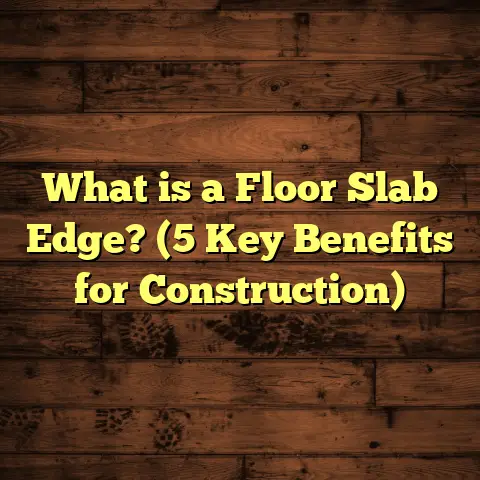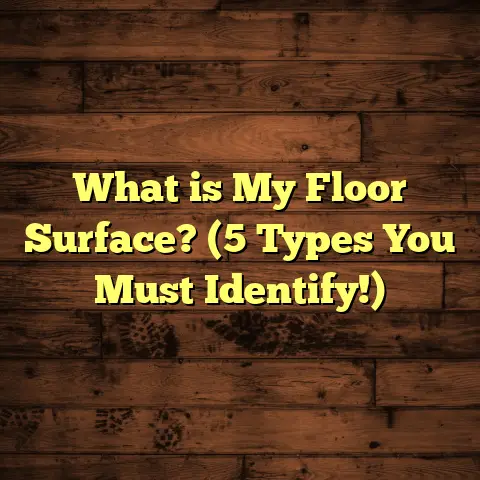What Is Soft or Hard Flooring? (5 Key Differences Explained)
Innovation and Flooring: A Personal Take
I’ve been in the flooring business for over a decade now, and one thing that never ceases to amaze me is how much innovation has shaped what’s possible under our feet. When I first started, the choices seemed simpler—mostly hardwood and carpet. But today, the variety and technology behind flooring materials have exploded. We have floors that can warm your toes on a cold day, floors that can mimic natural wood or stone so convincingly you’d swear they’re real, and floors engineered for durability that can handle the roughest wear and tear.
But this flood of options also made a core question even more significant: Should you go with soft flooring or hard flooring? This is not just about taste or budget; it’s about how the floor supports your lifestyle, affects your home’s atmosphere, and stands up to everyday realities. Over the years, I’ve helped hundreds of homeowners wrestle with this choice. Today, I want to share with you what I’ve learned—what soft and hard flooring really are, their strengths and weaknesses, and how you can decide which fits your life best.
What Is Soft or Hard Flooring?
The terms “soft” and “hard” flooring might sound self-explanatory, but they cover a surprisingly broad range of materials and experiences. Let me clarify what I mean when I talk about these two categories.
Soft Flooring
Soft flooring refers primarily to materials that provide some cushion or give when you step on them. This category includes:
- Carpet: From plush shag to low-pile commercial-grade carpets.
- Cork: Made from the bark of cork oak trees, offering natural resilience.
- Rubber flooring: Often found in gyms or playrooms.
- Certain vinyl or cushioned vinyl: Vinyl products with a softer backing layer.
These materials absorb impact, reduce noise, and generally feel warmer and more forgiving underfoot. Soft flooring is often chosen for comfort-focused spaces like bedrooms, kids’ rooms, or lounges.
Hard Flooring
Hard flooring typically refers to solid surfaces that don’t compress underfoot. This includes:
- Hardwood: Solid wood planks or engineered wood.
- Tile: Ceramic, porcelain, or natural stone tiles.
- Laminate: A synthetic product that mimics wood or stone.
- Stone: Marble, granite, slate.
- Concrete: Polished or stained concrete floors.
Hard floors are durable, easy to clean, and often considered more stylish by people wanting sleek modern or classic traditional looks.
The Story Behind Soft vs. Hard Flooring Choices: Successes and Challenges
Let me tell you about a few projects that really highlight the successes and challenges of choosing between soft and hard flooring.
A few years back, I worked with a young couple renovating their starter home. They wanted soft flooring because they’d just had their first baby. They imagined warm carpet everywhere so their little one could crawl safely. That made total sense to me. We installed plush carpet in the nursery and living room. The parents loved how cozy it felt.
But after six months, they called me with a problem—the carpet in the living room was stained from spills and pet accidents. They hadn’t realized how much effort regular carpet upkeep required. That was a challenge: soft floors bring comfort but demand vigilance in maintenance.
Contrast that with another client—a retired couple who wanted a low-maintenance home they could enjoy without worry. We installed hardwood throughout most of the house. They loved how easy it was to clean, how timeless it looked, and how it held up after years of wear. The one downside? The floors felt cold in winter mornings until they added area rugs.
From these stories, I learned that there’s no one-size-fits-all solution. Your lifestyle, pets, children, budget, and even climate influence what kind of floor fits best.
Five Key Differences Between Soft and Hard Flooring
Breaking down what really sets soft and hard flooring apart helps when you’re weighing your options.
1. Comfort and Feel Underfoot
Soft flooring provides a cushioned feel that many people find more comfortable for standing or walking long periods. Carpets especially offer warmth by trapping heat close to the floor surface. Cork floors also help reduce fatigue by absorbing impact.
I remember installing cork floors for a small home office for a client who worked from home. She told me how her feet didn’t ache after long hours sitting at her desk—something she hadn’t experienced before.
Hard floors like tile or hardwood don’t absorb shock as much. They can feel cold and unforgiving unless paired with rugs or mats.
Stat Alert: Research from the American Podiatric Medical Association found that cushioned flooring can reduce lower limb fatigue by up to 30%, especially for people who stand for work.
2. Durability and Lifespan
When it comes to lasting power, hard floors generally dominate. Hardwood floors can last 50 years or more with proper care; tile can last even longer without major damage.
Soft floors like carpet typically wear out faster—often within 5-10 years in busy homes—due to staining, matting, and fiber breakdown.
Laminate flooring is an interesting middle ground. It’s technically a hard surface but tends to have a shorter lifespan (10-20 years) compared to solid hardwood.
In my experience:
- Hardwood floors in high-traffic areas sometimes develop scratches but can be sanded and refinished.
- Carpets in kids’ rooms often show wear quickly from jumping and spills.
- Cork floors resist dents better than hardwood but can be damaged by moisture.
3. Maintenance Needs
You’ll save time with hard floors if you prefer low-maintenance options. Sweeping and mopping usually do the trick.
Soft floors require frequent vacuuming, stain treatments, and periodic deep cleaning. I’ve seen clients frustrated by stubborn stains on living room carpets after parties or pet mishaps.
One tip I always share is to act fast when spills occur on carpets—blot immediately rather than rubbing—to avoid permanent staining.
4. Cost Considerations
Upfront costs for soft flooring tend to be lower but replacement costs can add up over time due to shorter lifespans.
Hard flooring often requires higher initial investment but offers better long-term value if maintained well.
Here’s a rough cost comparison per square foot (materials + installation):
| Flooring Type | Cost Range (USD) | Expected Lifespan |
|---|---|---|
| Carpet | $3 – $7 | 5 – 10 years |
| Cork | $5 – $12 | 10 – 15 years |
| Hardwood | $8 – $15 | 30+ years |
| Laminate | $4 – $8 | 10 – 20 years |
| Porcelain Tile | $7 – $15 | 50+ years |
Important note: These costs vary widely based on quality, region, labor charges, and project complexity.
5. Aesthetic and Design Flexibility
Hard floors offer enormous design versatility—from rustic hardwoods to shining marble tiles—allowing you to achieve many styles.
Soft floors bring warmth and softness that hard surfaces can’t replicate easily. Modern carpets come in countless colors and textures—from plush velvet-like piles to flat commercial-grade fibers.
Personally, I often suggest blending both types for best effect—hard floors in main areas for durability paired with rugs or carpets in lounging spaces for warmth.
What I’ve Learned About Installation Realities
Installation challenges differ greatly between soft and hard flooring as well.
Soft Flooring Installation
Carpet installation requires precise measurements for wall-to-wall coverage plus padding underneath for comfort and longevity. Padding quality is critical; cheap padding leads to quicker carpet wear.
Cork installation demands careful subfloor preparation because cork tiles expand with moisture changes. Without proper acclimation before installation, cork can buckle or gap later on.
Vinyl and rubber floorings usually come in rolls or tiles that are glued or clicked together—installation is generally straightforward but must be done on smooth subfloors.
Hard Flooring Installation
Hardwood installation is often the most labor-intensive. Solid wood needs acclimation time before installation to prevent warping later due to moisture changes. It can be nailed down or glued depending on subfloor type.
Tile installation involves multiple steps—laying mortar bed, placing tiles evenly with spacers, grouting—and requires skilled labor for best results.
Laminate is one of the easiest hard floorings to install as a floating floor system without glue or nails.
From my experience managing crews over the years:
- I’ve seen rushed installations cause problems like uneven floors or early damage.
- Proper subfloor prep is non-negotiable regardless of flooring type.
- Local climate impacts installation timing: humid regions need longer acclimation periods.
Maintenance Stories: What Works Best?
Let me share some personal maintenance stories that underline how different flooring types behave over time.
One client had plush wall-to-wall carpet installed in their living room but struggled with pet hair buildup despite vacuuming daily. After two years, they switched to an area rug over hardwood floors for easier upkeep while keeping some softness.
Another homeowner with porcelain tile swore by weekly mopping with mild detergent to keep grout lines clean. They found tile virtually stain-proof compared to their old carpeted kitchen floors prone to food stains.
For cork floors, I recommend sealing every few years because cork’s porous nature can absorb spills if unprotected. One family I worked with neglected resealing their cork floor for five years; small water stains became visible near sinks until refinished professionally.
Environmental Impact: A Growing Concern
Sustainability is increasingly influencing flooring choices today. Here’s what I’ve noticed:
Soft Flooring Sustainability
- Carpet: Traditional nylon carpets are petroleum-based and not biodegradable but newer options use recycled materials.
- Cork: Highly sustainable since harvested from bark without cutting down trees; renewable every 9 years.
- Rubber: Some brands use recycled tires but overall impact depends on sourcing.
Hard Flooring Sustainability
- Hardwood: Responsible forestry certifications (FSC) ensure sustainable harvesting practices.
- Bamboo: Technically grass but used as hard flooring; fast-growing and renewable.
- Tile/Stone: Natural materials last long but energy-intensive production processes impact footprint.
- Concrete: Can be eco-friendly if using recycled content but energy-heavy curing process.
In my projects, I always encourage clients interested in “green” building to consider cork or bamboo as eco-conscious soft/hard hybrid options.
The Future of Flooring: What’s Next?
Innovation hasn’t slowed down since I began this work. Here are some trends I’m seeing that might affect your choice between soft vs hard floors:
- Smart Flooring: Floors embedded with sensors for heating control or health monitoring.
- Improved Cushioning Technologies: New materials offering the comfort of soft floors without sacrificing durability.
- Recycled and Sustainable Materials: Increasing availability of eco-friendly options across both categories.
- Hybrid Floors: Products combining soft top layers on hard bases for best of both worlds.
I recently tested a new product combining cork’s softness with a waterproof laminate base that looked promising for kitchens—a great example of innovation blurring traditional lines between soft and hard flooring.
Let Me Help You Decide: Questions to Ask Yourself
Choosing between soft or hard flooring boils down to a few key questions I always discuss with clients:
- How much foot traffic will this area get?
- Do you have pets or children who might cause stains or damage?
- How much time can you realistically spend on cleaning?
- What’s your budget both short-term (installation) and long-term (maintenance/replacement)?
- Do you prefer warmth underfoot or sleek solid surfaces?
- What style fits your home décor?
Answering these helps narrow choices significantly before looking at samples or prices.
Final Thoughts from My Experience
From working on all kinds of homes—from busy family houses to quiet retirees’ retreats—I know there’s no single “best” answer when choosing soft vs hard flooring. It really depends on what you value most day-to-day.
Soft floors offer comfort but need care; hard floors offer durability but sometimes less warmth. Many find mixing both works wonders—hard floors where durability matters most paired with soft areas for coziness.
If you want detailed advice tailored exactly to your project—feel free to ask me! I love helping people find the perfect balance so their floors serve them beautifully for years to come.





